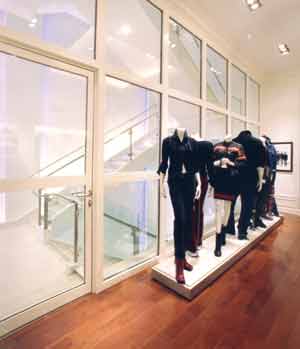Designing with Fire-Rated Glass: Integrating Life Safety, Transparency, and Aesthetics
Learning Objectives:
- Identify key categories of fire-rated glazing.
- Evaluate viable fire-rated options for various applications.
- Understand the relationship between glass and sprinklers.
Credits:
Developments in glazing techniques and technology are providing new design opportunities for use of fire-rated glass. Traditional wired glass, as opposed to newer laminated wired glass, has long been the only glazing material permitted in fire-rated areas, as set forth by local building codes. Complying with a fire rating often meant giving up clear visibility through doors and windows, due to the wires, and sacrificing impact safety, since wired glass is easy to break. Design choices often consisted of creating a solid wall without windows, or an opening with institutional-looking wired glass, with its inherent performance limitations.
As a result, glass manufacturers have created new solutions, thereby providing more options and a sophisticated range of materials for a variety of applications. These choices offer many levels of performance that directly influence project design and construction requirements.
|
Fire-rated glass has two primary functions: to protect life and property in the event of a fire, and to allow visibility. A solid barrier wall can often give adequate fire protection, but it blocks light and vision from one space to another. At the other end of the spectrum, ordinary window glass lets the light in but does nothing to stop the spread of a fire. Fire-rated glass combines both functions in a single product, maintaining a barrier to flames and smoke while at the same time opening up a room visually.
Glass must undergo rigorous testing to earn a fire rating. Several pieces of different sizes are installed in a test furnace and then subjected to a blaze that exceeds 1600° F. To successfully pass the test, glass must remain in the frame for the duration of the test. The longer it can withstand the heat, the higher the fire rating it can be given, from 20 minutes to 3 hours.
After the fire test, if the glass is to be given anything above a 20-minute rating, it must also endure a hose stream test. While the glass is still hot, it is doused with a blast from a fire hose. Most glass cannot tolerate the difference in temperatures and will shatter. This can be a critical factor in a real-world fire, where hot glass may be exposed to water from hoses, sprinklers or extinguishers. The rare types of glass that are able to survive these grueling conditions earn the right to be considered "fire-rated."
Once thought of as a design limitation, fire-rated glass has become a resource for innovative design concepts. Meeting life safety and building code requirements can be integrated with creative design alternatives, rather than purely functional solutions.
Building codes are beginning to reflect the changes in the industry. Revisions to the 2003 International Building Code (IBC) have eliminated the use of traditional wired glass for hazardous locations in schools, daycare centers, and athletic facilities. These changes will apply to all types of construction in 2006.
This marks a significant shift, because wired glass, a product once mandatory in all glazed fire-rated openings, is no longer considered adequate for many building types.










